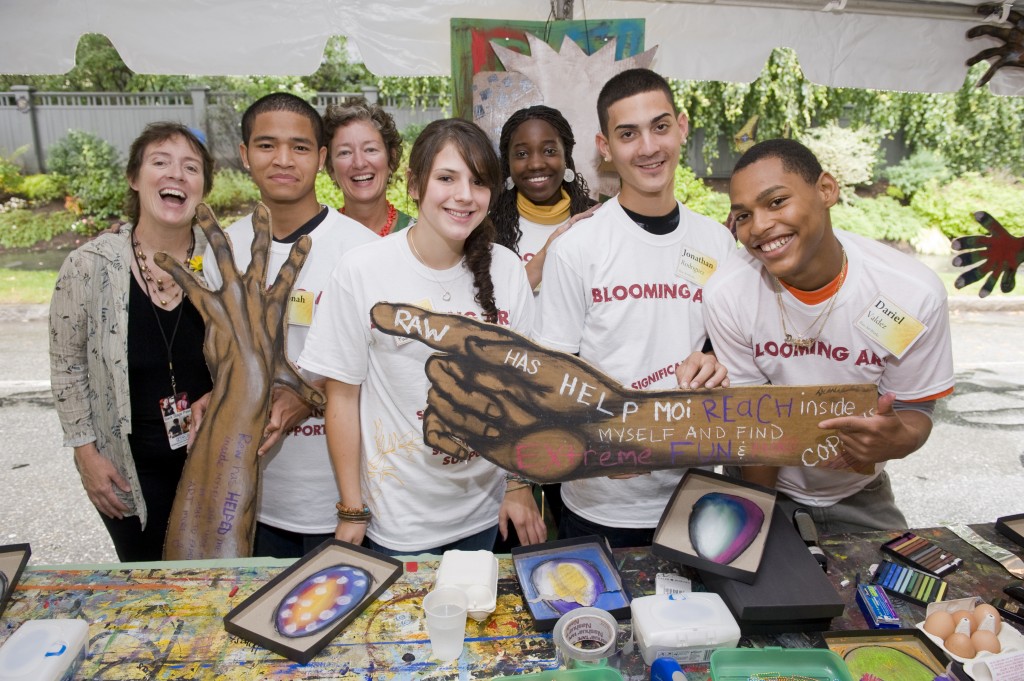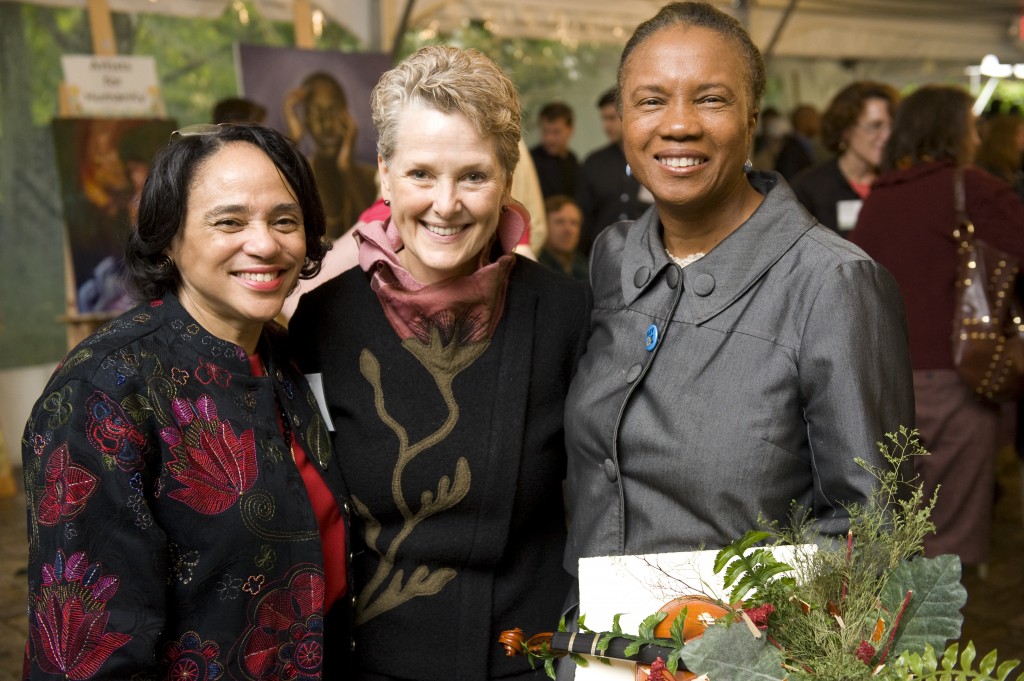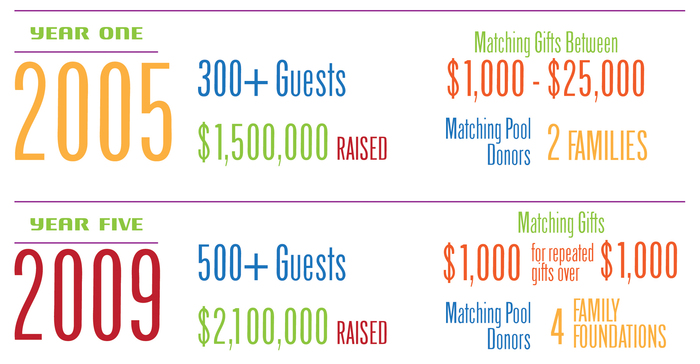
Raw Art Works students and staff proudly display the fruits of their labor at Blooming Art 2008.
Ambassador Swanee Hunt and her late husband, Maestro Charles Ansbacher, opened their historic home and garden to host the showcase with their neighbors Ann and Graham Gund, who were also very generous supporters of local arts organizations.
A stage and large tent were erected for performances, with booths for each of the 30 coalition member organizations scattered around the abutting yards.
As guests arrived, they were serenaded as they walked up the driveway, young actors performed Shakespearean monologues, and painters created portraits and murals. Guests were greeted and encouraged to wander through the house and yards to experience the variety of artistic performances and exhibits.
A mix of dance, theater, and music performances took place on the main stage; the intermission was used to allow guests to explore the booths of organizations they hadn’t yet seen. After additional performances, the event concluded with a keynote address and a final performance.
Throughout the event, Emcees encouraged guests to visit booths, create art, and talk with young artists and leaders of the organizations represented at Blooming Art. The staff and volunteer leaders of the coalition organizations shared their elevator pitches with prospective donors, and engaged in deeper conversations with guests who were moved or intrigued by what they saw. Those guests signed pledge cards—committing thousands of dollars that would then be nearly doubled by the matching funds pool.
Blooming Art produced new donors and board members for coalition organizations. The mission of using the arts to help young people stay on track, finish school, and find purpose in their lives was seen and understood by hundreds of people, many of whom became donors whose support continued well after the last Blooming Art showcase was held, in 2009.
Pre-Planning Retreat
For each of the five years that the Blooming Art showcase was organized, the planning process started with a half-day retreat. The goals of this session were to generate excitement for the event; discuss lessons learned at the prior year’s event; and provide an opportunity for coalition members to share successes and challenges with their peers.
A significant focus of these meetings was the annual discussion of the policies and procedures around the matching funds pool. Organizations came to these discussions with a variety of viewpoints; generally, smaller organizations lobbied to have the matching pool funds divided evenly among all coalition members, while larger organizations preferred that the guidelines for the match become more restrictive each year to encourage ever-larger gifts from donors.
Host Committee
The host committee for Blooming Art events included major arts supporters, coalition board members, political allies, and policymakers. The group’s diversity represented the broad spectrum of support for youth arts in eastern Massachusetts. Committee members learned about the ARTWorks model and the goals of Blooming Art; each invited friends to attend the event, and donated to coalition members of their choice. The committee gave candid feedback about the event and advice to coalition members seeking to cultivate individual donors.
We intentionally included policymakers in the host committee each year. Their participation helped them understand the youth arts mission and led them to see coalition members as allies and community resources.

Blooming Art events were served as an opportunity for coalition members to build their donor base and interact with community leaders by showcasing talented youth from their programs. In 2009, then Boston Public Schools Superintendent Dr. Carol Johnson (left) and then Major of Cambridge Denise Simmons (right) were among the featured guests.
The expectations of host committee members:
- Recommend others to join;
- Attend one breakfast with Swanee and Charles at their home;
- Invite at least 10 friends to attend the showcase;
- Be willing to be listed in the invitation and event catalog;
- Attend the event;
- Donate to at least one organization at the event; and
- Participate in follow-up with friends who were invited to encourage giving.
The host committee was publicly recognized at the event and were given a small gift, usually something created by one of the youth artists.
Building the Audience
Coalition members were persuaded to invite their largest donors with the promise of matching funds. The hosts of the first Blooming Art established a matching funds pool of $500,000 for major gifts – $1,000 or more from new donors to an organization, or an increase of $1,000 over past giving from current donors – that were pledged at the event and fulfilled within a month after the showcase event.
The full invitation list for the event was never shared with the entire coalition, in order to respect the privacy of the individual donors. ARTWorks program staff were the only people who could access the full list.
Blooming Art benefited from having Hunt Alternatives as a central convener to arrange logistics and effectively promote the event. ARTWorks program staff coordinated all aspects of the event, allowing coalition members to focus on donor cultivation and preparing their youth artists.
Expectations and Benefits for Youth Arts Organizations
Blooming Art was time-intensive for coalition members, but the benefits were substantial. Every coalition organization:
- cultivated potential and current donors;
- organized youth performances and activities;
- collaborated to plan the event and evaluate it afterwards; and
- contributed to collateral, most notably the event catalog, that went home with donors as a tangible reminder of the great work they’d just experienced.
Event Walkthrough and Workshop
Two weeks prior to each showcase, program staff and coalition members met to walk through the event space and map out the exhibits, performance space, and staging areas. Performing groups met with the event manager and sound crew to run through the timing and technical needs of their pieces, but did not need a traditional dress rehearsal. Communications coaching was provided to those organization leaders who would be speaking on stage.
Additional coaching was provided as needed: on how to mobilize board members and staff to engage current and prospective donors; how to help volunteers understand the matching funds policies; how best to feature the youth artists; and how to prepare early for donor follow-up.
